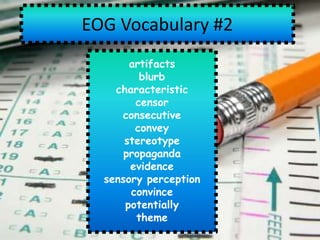
Eog Vocab 3
- 1. EOG Vocabulary #2 artifacts blurb characteristic censor consecutive convey stereotype propaganda evidence sensory perception convince potentially theme
- 2. artifacts – an object made by human beings or the remains of objects made by human beings
- 3. blurb - a brief advertisement or announcement, especially a complimentary one
- 4. characteristic - a distinguishing feature or quality
- 5. censor - an official who examines books, plays, news reports, motion pictures, radio and television programs, letters, etc., for the purpose of suppressing (getting rid off) parts deemed objectionable on moral, political, military, or other grounds
- 6. consecutive - following one another in uninterrupted succession or order; successive: six consecutive numbers, such as 5, 6, 7, 8, 9, 10.
- 7. convey - to communicate; impart; make known: to convey a wish Click on picture for article explaining!
- 8. stereotype - a simplified and standardized conception or image of a person or group of people
- 9. propaganda - information, ideas, or rumors deliberately spread widely to help or harm a person, group, movement, institution, nation, etc.
- 10. clarify – to make something clear or easy to understand
- 11. sensory perception – an awareness or understanding you get from your sense processes based on something you see or hear/perceive.
- 12. convince - to change someone’s opinion by arguing or presenting evidence; to changes someone’s beliefs or decision through your words
- 13. potentially – possibly, but not yet actually
- 14. theme – an important idea